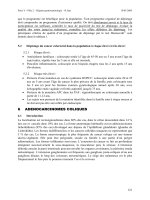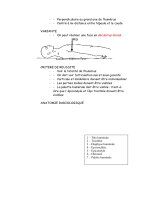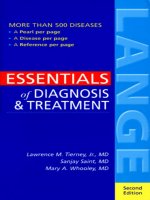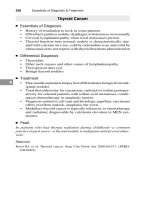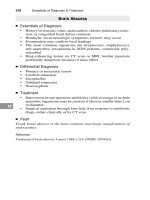DIAGNOSIS & TREATMENT - PART 5 potx
Bạn đang xem bản rút gọn của tài liệu. Xem và tải ngay bản đầy đủ của tài liệu tại đây (462.93 KB, 54 trang )
Varicella (Acute Chickenpox, Zoster [Shingles])
■
Essentials of Diagnosis
• Acute varicella: fever, malaise with eruption of pruritic, centripetal,
papular rash, vesicular and pustular before crusting; lesions in all
stages at any given time; “drop on rose petal” is the first lesion
• Incubation period 14–21 days
• Bacterial infection, pneumonia, and encephalitis may complicate
• Reactivation varicella (herpes zoster): dermatomal distribution,
vesicular rash with pain often preceding eruption
■
Differential Diagnosis
• Other viral infections
• Drug allergy
■
Treatment
• Supportive measures with topical lotions and antihistamines;
antivirals (acyclovir, valacyclovir, famciclovir) for all adults with
varicella
• Immune globulin or antivirals for exposed susceptible immuno-
suppressed or pregnant patients
• Acyclovir early for immunocompromised or pregnant patients,
severe disease (eg, pneumonitis, encephalitis), or ophthalmic
division of trigeminal nerve involvement with zoster
• Corticosteroids combined with antiviral agent with rapid taper
may diminish postherpetic neuralgia in older patients with zoster
■
Pearl
Epidemics are more frequent in winter and spring and in temperate cli-
mates.
Reference
Weller TH: Varicella: historical perspective and clinical overview. J Infect Dis
1996;174(Suppl 3):S306. [PMID: 8896536]
202 Essentials of Diagnosis & Treatment
8
Mumps (Epidemic Parotitis)
■
Essentials of Diagnosis
• Painful, swollen salivary glands , usually parotid; may be unilateral
• Incubation period 12–24 days
• Orchitis or oophoritis, meningoencephalitis, or pancreatitis may
occur
• Cerebrospinal fluid shows lymphocytic pleocytosis in meningo-
encephalitis with hypoglycorrhachia
• Diagnosis confirmed by isolation of virus in saliva or appearance
of antibodies after second week
■
Differential Diagnosis
• Parotitis or enlarged parotids due to other causes (eg, bacteria,
sialolithiasis, cirrhosis, diabetes, starch ingestion, Sjögren’s syn-
drome, sarcoidosis, tumor)
• Aseptic meningitis, pancreatitis, or orchitis due to other causes
■
Treatment
• Immunization is preventive
• Supportive care with surveillance for complications
■
Pearl
Mumps is a treatable cause of sterility, associated with high blood FSH
and low testosterone levels.
Reference
McQuone SJ: Acute viral and bacterial infections of the salivary glands. Oto-
laryngol Clin North Am 1999;32:793. [PMID: 10477787]
Chapter 8 Infectious Diseases 203
8
Viral Encephalitis
■
Essentials of Diagnosis
• Most common agents include enterovirus, Epstein-Barr virus,
and viruses of herpes simplex, measles, rubella, rubeola, vari-
cella, West Nile fever
• Fever, malaise, stiff neck, nausea, altered mentation
• Signs of upper motor neuron lesion: exaggerated deep tendon
reflexes, absent superficial reflexes, spastic paralysis
• Increased cerebrospinal fluid protein with lymphocytic pleocyto-
sis, occasional hypoglycorrhachia
• Isolation of virus from blood or cerebrospinal fluid; serology pos-
itive in paired specimens 3–4 weeks apart
• Brain imaging shows temporal lobe abnormalities in herpetic
encephalitis
■
Differential Diagnosis
• Other encephalitides (postvaccination, Reye’s syndrome, toxins)
• Lymphocytic choriomeningitis
• Primary or secondary neoplasm
• Bacterial meningitis or brain abscess
■
Treatment
• Vigorous supportive measures with attention to elevated central
nervous system pressures
• Mannitol in selected patients
• Acyclovir for suspected herpes simplex encephalitis; other specific
antiviral therapy is under study
■
Pearl
In patients with suspected encephalitis, acyclovir is given until herpes
is excluded.
Reference
Roos KL: Encephalitis. Neurol Clin 1999;17:813. [PMID: 10517930]
204 Essentials of Diagnosis & Treatment
8
Poliomyelitis
■
Essentials of Diagnosis
• Enterovirus acquired via fecal-oral route; vast majority of symp-
tomatic cases are not neurologic
• Muscle weakness, malaise, headache, fever, nausea, abdominal
pain, sore throat
• Signs of lower motor neuron lesions: asymmetric, flaccid paral-
ysis with decreased deep tendon reflexes, muscle atrophy; may
include cranial nerve abnormalities (bulbar form)
• Cerebrospinal fluid lymphocytic pleocytosis with slight elevation
of protein
• Virus recovered from throat washings or stool
■
Differential Diagnosis
• Other aseptic meningitides
• Postinfectious polyneuropathy (Guillain-Barré syndrome)
• Amyotrophic lateral sclerosis
• Myopathy
■
Treatment
• Vaccination is preventive and has eliminated the disease in the
United States
• Supportive care with particular attention to respiratory function,
skin care, and bowel and bladder function
■
Pearl
Stiff neck after an enteric illness is a potential precursor of neurologic
polio.
Reference
Melnick JL: Current status of poliovirus infections. Clin Microbiol Rev
1996;9:293. [PMID: 8809461]
Chapter 8 Infectious Diseases 205
8
Lymphocytic Choriomeningitis
■
Essentials of Diagnosis
• History of exposure to mice or hamsters
•“Influenza-like” prodrome with fever, chills, headache, malaise,
and cough followed by headache, photophobia, or neck pain
• Kernig and Brudzinski signs positive
• Cerebrospinal fluid with lymphocytic pleocytosis and slight in-
crease in protein
• Serology for arenavirus positive 2 weeks after onset of symp-
toms; virus recovered from blood and cerebrospinal fluid
• Illness usually lasts 1–2 weeks
■
Differential Diagnosis
• Other aseptic meningitides
• Bacterial or granulomatous meningitis
■
Treatment
• Supportive care
■
Pearl
One of the few causes of hypoglycorrhachia in a patient who appears
to be well.
Reference
Barton LL et al: Lymphocytic choriomeningitis virus: reemerging central ner-
vous system pathogen. Pediatrics 2000;105:E35. [PMID: 10699137]
206 Essentials of Diagnosis & Treatment
8
Dengue (Breakbone Fever, Dandy Fever)
■
Essentials of Diagnosis
• A viral (togavirus, flavivirus) illness transmitted by the bite of the
Aedes mosquito
• Sudden onset of high fever, chills, severe myalgias, headache,
sore throat
• Biphasic fever curve with initial phase of 3–4 days, short remis-
sion, and second phase of 1–2 days
• Rash is biphasic—first evanescent, followed by maculopapular,
scarlatiniform, morbilliform, or petechial changes during remis-
sion or second phase of fever; first in the extremities and spreads
to torso
• Dengue hemorrhagic fever is a severe form in which gastro-
intestinal hemorrhage is prominent and patients often present with
shock
■
Differential Diagnosis
• Malaria
• Yellow fever
• Influenza
• Typhoid fever
• Borreliosis
• Other viral exanthems
■
Treatment
• Supportive care
• Vaccine has been developed but not commercially available
■
Pearl
Dengue should always be considered in the febrile returned traveler
with presumed influenza.
Reference
Rigau-Pérez JG et al: Dengue and dengue haemorrhagic fever. Lancet
1998;352:971. [PMID: 9752834]
Chapter 8 Infectious Diseases 207
8
Colorado Tick Fever
■
Essentials of Diagnosis
• A self-limited acute viral (coltivirus) infection transmitted by
Dermacentor andersoni tick bites
• Onset 3–6 days following bite
• Abrupt onset of fever, chills, myalgia, headache, photophobia
• Occasional faint rash
• Second phase of fever after remission of 2–3 days common
• Imbedded ticks, especially in children’s scalps, may cause paresis
■
Differential Diagnosis
• Borrelliosis
• Influenza
• Adult Still’s disease
• Other viral exanthems
• Guillain-Barré syndrome (if paralysis present)
■
Treatment
• Supportive for uncomplicated cases
• With paresis, removal of tick results in prompt resolution of
symptoms
■
Pearl
A tick-borne disease of the western mountains not associated with
paralysis.
Reference
Attoui H: Serologic and molecular diagnosis of Colorado tick fever viral infec-
tions. Am J Trop Med Hyg 199859:763. [PMID: 9840594]
208 Essentials of Diagnosis & Treatment
8
Rabies
■
Essentials of Diagnosis
• A rhabdovirus encephalitis transmitted by infected saliva
• History of animal bite (bats, bears, skunks, foxes, raccoons; dogs
and cats in developing countries)
• Paresthesias, hydrophobia, rage alternating with calm
• Convulsions, paralysis, thick tenacious saliva and muscle spasms
■
Differential Diagnosis
• Tetanus
• Encephalitis due to other causes
■
Treatment
• Active immunization of household pets and persons at risk (eg,
veterinarians)
• Thorough, repeated washing of bite and scratch wounds
• Postexposure immunization, both passive and active
• Observation of healthy biting animals, examination of brains of
sick or dead biting animals
• Treatment is supportive only; disease is almost uniformly fatal
■
Pearl
Bats are the most common vector for rabies in the United States, and
even absent history of a bite, children exposed to bats indoors should
be immunized.
Reference
Plotkin SA: Rabies. Clin Infect Dis 1998;59:763. [PMID: 10619725]
Chapter 8 Infectious Diseases 209
8
Influenza
■
Essentials of Diagnosis
• Caused by an orthomyxovirus transmitted via the respiratory route
• Abrupt onset of fever, headache, chills, malaise, dry cough, coryza,
and myalgias; constitutional signs out of proportion to catarrhal
symptoms
• Epidemic outbreaks in fall or winter, with short incubation period
• Virus isolated from throat washings; serologic tests positive after
second week of illness
• Complications include bacterial sinusitis, otitis media, and pneu-
monia
• Myalgias occur early in course, rhabdomyolysis late
■
Differential Diagnosis
• Other viral syndromes
• Primary bacterial pneumonia
• Meningitis
• Dengue in returned travelers
• Rhabdomyolysis of other cause
■
Treatment
• Yearly active immunization of persons at high risk (eg, chronic
respiratory disease, pregnant women, cardiac disease, health care
workers, immunosuppressed); also for all over 50
• Chemoprophylaxis for epidemic influenza A effective with aman-
tadine; zanamivir and oseltamivir effective against influenza A
and B
• Antivirals reduce duration of symptoms and infectivity if given
within 48 hours
• Avoid salicylates in children because of association with Reye’s
syndrome
■
Pearl
Complicating staphylococcal pneumonia is the most common cause of
death in epidemics.
Reference
Stamboulian D: Influenza. Infect Dis Clin North Am 2000;14:141. [PMID:
10738677]
210 Essentials of Diagnosis & Treatment
8
Infectious Mononucleosis
(Epstein-Barr Virus Infection)
■
Essentials of Diagnosis
• An acute viral illness due to EBV, usually occurring up to age 35
but any age possible
• Transmitted by saliva; incubation period is 5–15 days or longer
• Fever, severe sore throat, striking malaise, lymphadenopathy
• Maculopapular rash, splenomegaly common
• Leukocytosis and lymphocytosis with atypical large lymphocytes
by smear; positive heterophil agglutination test (Monospot) by
fourth week of illness; false-positive rapid plasma reagin test
(RPR) in 10%
• Clinical picture much less typical in older patients
• Complications include splenic rupture, hepatitis, myocarditis,
thrombocytopenia, and encephalitis
■
Differential Diagnosis
• Other causes of pharyngitis
• Other causes of hepatitis
• Toxoplasmosis
• Rubella
• Acute HIV, CMV, or rubella infections
• Acute leukemia or lymphoma
• Kawasaki syndrome
• Hypersensitivity reaction due to carbamazepine
■
Treatment
• Supportive care only; fever usually disappears in 10 days, lymph-
adenopathy and splenomegaly in 4 weeks
• Ampicillin apt to cause rash
• Avoid vigorous abdominal activity or exercise
■
Pearl
Mononucleosis is the most common cause of the otherwise rare anti-i
hemolytic anemia.
Reference
Cohen JI: Epstein-Barr virus infection. N Engl J Med 2000;343:481. [PMID:
10944566]
Chapter 8 Infectious Diseases 211
8
RICKETTSIAL INFECTIONS
Rocky Mountain Spotted Fever (Rickettsia rickettsii)
■
Essentials of Diagnosis
• Exposure to tick bite in endemic area
• Influenzal prodrome followed by chills, fever, severe headache,
myalgias, occasionally delirium and coma
• Red macular rash with onset between second and sixth days of
fever; first on extremities, then centrally, may become petechial
or purpuric
• Leukocytosis, proteinuria, hematuria
• Serologic tests positive by second week of illness, but diagnosis
may be made earlier by skin biopsy with immunologic staining
■
Differential Diagnosis
• Meningococcemia
• Endocarditis
• Gonococcemia
• Ehrlichiosis
• Measles
■
Treatment
• Tetracyclines or chloramphenicol
• Vaccine in development
■
Pearl
Despite the name, Rocky Mountain spotted fever is far more common
in the southeastern United States.
Reference
Thorner AR et al: Rocky Mountain spotted fever. Clin Infect Dis 1998;27:1353.
[PMID: 9868640]
212 Essentials of Diagnosis & Treatment
8
Q Fever (Coxiella burnettii)
■
Essentials of Diagnosis
• Infection following exposure to sheep, goats, cattle, or fowl
• Acute or chronic febrile illness with severe headache, cough, and
abdominal discomfort
• Pulmonary infiltrates by chest x-ray; leukopenia
• Serologic confirmation by third to fourth weeks of illness
• Granulomatous hepatitis and culture-negative endocarditis in
occasional cases
■
Differential Diagnosis
• Atypical pneumonia
• Granulomatous hepatitis due to other cause
• Brucellosis
• Other causes of culture-negative endocarditis
■
Treatment
• Tetracyclines suppressive but not always curative, especially
with endocarditis; surgery may be necessary
• Vaccine being developed
■
Pearl
Some recent outbreaks are laboratory-acquired where sheep are used
in cardiovascular research.
Reference
Maurin M: Q fever. Clin Microbiol Rev 1999;12:518. [PMID: 10515901]
Chapter 8 Infectious Diseases 213
8
BACTERIAL INFECTIONS
Streptococcal Pharyngitis
■
Essentials of Diagnosis
• Abrupt onset of sore throat, fever, malaise, nausea, headache
• Pharynx erythematous and edematous with exudate; cervical
adenopathy
• Strawberry tongue
• Throat culture or rapid antigen detection confirmatory
• If erythrotoxin (scarlet fever) is produced, scarlatiniform rash red
and papular with petechiae and fine desquamation; prominent in
axilla, groin, behind knees
• Glomerulonephritis, rheumatic fever may complicate
■
Differential Diagnosis
• Viral pharyngitis
• Mononucleosis
• Diphtheria
• With rash: meningococcemia, toxic shock syndrome, drug reac-
tion, viral exanthem
■
Treatment
• For two or more clinical criteria (cervical adenopathy, fever, exu-
date, and absence of rhinorrhea): empiric penicillin
• If equivocal, await culture or antigen confirmation
• If history of rheumatic fever, continuous antibiotic prophylaxis
for 5 years
■
Pearl
Despite the clinical severity of pharyngeal diphtheria, fever is higher
in strep throat.
Reference
Bisno AL: Acute pharyngitis. N Engl J Med 2001;344:205. [PMID: 11172144]
214 Essentials of Diagnosis & Treatment
8
Streptococcal Skin Infection
■
Essentials of Diagnosis
• Erysipelas: rapidly spreading cutaneous erythema and edema
with sharp borders
• Impetigo: rapidly spreading erythema with vesicular or denuded
areas and salmon-colored crust
• Culture of wound or blood grows group A beta hemolytic strep-
tococci
• Complication: glomerulonephritis
■
Differential Diagnosis
• Other causes of infectious cellulitis (eg, staphylococcal, E coli)
• Toxic shock syndrome
• Beriberi (in setting of thiamin deficiency)
■
Treatment
• Penicillin for culture-proved streptococcal infection
• Staphylococcal coverage (dicloxacillin) for empiric therapy or
uncertain diagnosis
■
Pearl
Group A cutaneous infections can result in glomerulonephritis but not
rheumatic fever.
Reference
Bisno AL et al: Streptococcal infections of skin and soft tissues. N Engl J Med
1996;334:240. [PMID: 8532002]
Chapter 8 Infectious Diseases 215
8
Pneumococcal Infections
■
Essentials of Diagnosis
• Pneumonia characterized by initial chill, severe pleuritis, fever
without diurnal variation; signs of consolidation and lobar infil-
trate on x-ray ensue rapidly
• Leukocytosis, hyperbilirubinemia
• Gram-positive diplococci on Gram-stained smear of sputum;
lancet-shaped only on stained culture colonies
• Meningitis: rapid onset of fever, altered mental status and head-
ache; cerebrospinal fluid polymorphonuclear leukocytosis with
elevated protein and decreased glucose; Gram-stained smear of
fluid positive in 90% of cases
• Endocarditis, empyema, pericarditis, and arthritis may also com-
plicate, with empyema most common
• Predisposition to bacteremia in children under 24 months of age
or in asplenic or immunocompromised adults (eg, AIDS, elderly)
■
Differential Diagnosis
• Pneumonia, meningitis of other cause
• Pulmonary embolism
• Myocardial infarction
• Acute exacerbation of chronic bronchitis
• Acute bronchitis
• Gram-negative septicemia
■
Treatment
• Blood culture prior to antibiotics
• Third-generation cephalosporin for severe disease; add empiric
vancomycin for meningitis pending culture results
• Adults over 50 with any serious medical illness, patients with
sickle cell disease, and asplenic patients should receive pneumo-
coccal vaccine
• Penicillin unreliable pending results of susceptibility testing
■
Pearl
Rigors after the first day of infection in a patient with pneumonia sug-
gest a different etiology or an extrapulmonary complication.
Reference
Harwell JI: The drug-resistant pneumococcus: clinical relevance, therapy, and
prevention. Chest 2000;117:530. [PMID: 10669700]
216 Essentials of Diagnosis & Treatment
8
Staphylococcal Soft Tissue or Skin Infections
■
Essentials of Diagnosis
• Painful, pruritic erythematous rash with golden crusts or discharge
• Folliculitis, furunculosis, carbuncle, abscess, and cellulitis all seen
• Culture of wound or abscess is diagnostic; Gram-stained smear
positive for large gram-positive cocci (Staphylococcus aureus) in
clusters
■
Differential Diagnosis
• Streptococcal skin infections
■
Treatment
• Penicillinase-resistant penicillin or cephalosporin; erythromycin
may also be effective in some cases
• Drainage of abscess
• Persistence of blood culture positivity suggests endocarditis or
osteomyelitis
■
Pearl
Gram stain of material infected with staphylococci shows marked
avidity of the organisms for the stain; they also thrive intracellularly—
in contrast to pneumococci.
Reference
Thestrup-Pedersen K: Bacteria and the skin: clinical practice and therapy update.
Br J Dermatol 1998;139(Suppl)53:1. [PMID: 9990405]
Chapter 8 Infectious Diseases 217
8
Staphylococcus aureus-Associated Toxic
Shock Syndrome
■
Essentials of Diagnosis
• Abrupt onset of fever, vomiting, diarrhea, sore throat, headache,
myalgia
• Toxic appearance, with tachycardia and hypotension
• Diffuse maculopapular erythematous rash with desquamation on
the palms and soles; nonpurulent conjunctivitis
• Association with tampon use; culture of nasopharynx, vagina,
rectum, and wounds may yield staphylococci, but blood cultures
usually negative
• Usually caused by toxic shock syndrome toxin-1 (TSST-1)
■
Differential Diagnosis
• Streptococcal infection, particularly scarlet fever
• Gram-negative sepsis
• Rickettsial disease, especially Rocky Mountain spotted fever
■
Treatment
• Aggressive supportive care (eg, fluids, vasopressor medication,
monitoring)
• Antistaphylococcal antibiotics to eliminate source
■
Pearl
Consider chronic staphylococcal osteomyelitis as a potential cause of
toxic shock syndrome.
Reference
Bannan J et al: Structure and function of streptococcal and staphylococcal super-
antigens in septic shock. Infect Dis Clinics North Am 1999;13:387. [PMID:
10340173]
218 Essentials of Diagnosis & Treatment
8
Clostridial Myonecrosis (Gas Gangrene)
■
Essentials of Diagnosis
• Sudden onset of pain, swelling in an area of wound contamination
• Severe systemic toxicity and rapid progression of involved tissue
• Brown or blood-tinged watery exudate with surrounding skin dis-
coloration
• Gas in tissue by palpated or auscultated crepitus or x-ray
• Clostridium perfringens in anaerobic culture or smear of exudate
is the classic—but not the only—cause
■
Differential Diagnosis
• Other gas-forming infections (mixed aerobic and anaerobic enteric
organisms)
• Cellulitis due to staphylococcal or streptococcal infection
■
Treatment
• Immediate surgical debridement and exposure of infected areas
• Hyperbaric oxygen of uncertain benefit
• Intravenous penicillin with clindamycin
• Tetanus prophylaxis
■
Pearl
In a patient severely symptomatic and extremely toxic with the clinical
picture noted, a relatively low-grade fever is virtually diagnostic of gas
gangrene.
Reference
Chapnick EK: Necrotizing soft-tissue infections. Infect Dis Clinics North Am
1996;10:835.[PMID: 8958171] )
Chapter 8 Infectious Diseases 219
8
Tetanus (Clostridium tetani)
■
Essentials of Diagnosis
• History of nondebrided wound or contamination may or may not
be obtained
• Jaw stiffness followed by spasms (trismus)
• Stiffness of neck or other muscles, dysphagia, irritability, hyper-
reflexia; late, painful convulsions precipitated by minimal stim-
uli; fever is low-grade
■
Differential Diagnosis
• Infectious meningitis
• Rabies
• Strychnine poisoning
• Malignant neuroleptic syndrome
• Hypocalcemia
■
Treatment
• Active immunization preventive
• Passive immunization with tetanus immune globulin and con-
current active immunization for all suspected cases
• Chlorpromazine or diazepam for spasms or convulsions, with ad-
ditional sedation by barbiturates as necessary
• Vigorous supportive care with particular attention to airway and
laryngospasm
• Penicillin
■
Pearl
Tetanus should be high on the list in “skin-popping” illicit drug users
with increased muscle tone.
Reference
Ernst ME et al: Tetanus: pathophysiology and management. Ann Pharmacother
1997;31:1507. [PMID: 9416389]
220 Essentials of Diagnosis & Treatment
8
Botulism (Clostridium botulinum)
■
Essentials of Diagnosis
• Sudden onset of cranial nerve paralysis, diplopia, dry mouth, dys-
phagia, dysphonia, and progressive muscle weakness
• Fixed and dilated pupils in 50%
• In infants: irritability, weakness, and hypotonicity
• History of recent ingestion of home-canned, smoked, or vacuum-
packed foods
• Demonstration of toxin in serum or food
■
Differential Diagnosis
• Bulbar poliomyelitis
• Myasthenia gravis
• Posterior cerebral circulation ischemia
• Tick paralysis
• Guillain-Barré syndrome or variant
• Inorganic phosphorus poisoning
■
Treatment
• Removal of unabsorbed toxin from gut
• Specific antitoxin (CDC Poison Control Hotline 800-292-6678)
• Vigilant support, including attention to respiratory function
• Penicillin
■
Pearl
In intravenous drug users with cranial nerve findings, this picture is
classic for wound botulism caused by black tar heroin.
Reference
Shapiro RL et al: Botulism in the United States: a clinical and epidemiologic
review. Ann Intern Med 1998;129:221. [PMID: 9696731]
Chapter 8 Infectious Diseases 221
8
Anthrax (Bacillus anthracis)
■
Essentials of Diagnosis
• History of industrial or agricultural exposure (farmer, veterinarian,
tannery or wool worker); a potential agent in biological warfare
• Persistent necrotic ulcer on exposed surface
• Regional adenopathy, fever, malaise, headache, nausea and vom-
iting
• Inhalation of spores causes severe tracheobronchitis and pneu-
monia with dyspnea and cough
• Hematologic spread with profound toxic and cardiovascular col-
lapse may complicate either cutaneous or pulmonary form
• Confirmation of diagnosis by culture or specific fluorescent anti-
body test, but clinical picture highly suggestive
■
Differential Diagnosis
• Skin lesions: staphylococcal or streptococcal infection
• Pulmonary disease: tuberculosis, fungal infection, sarcoidosis,
lymphoma with mediastinal adenopathy, plague
■
Treatment
• Therapy for post exposure prophylaxis is oral doxycycline or oral
ciprofloxacin
• Optimal therapy for confirmed disease due to a susceptible strain
is oral amoxacillin or oral doxycycline for 60 days
• Mortality rate is high despite proper therapy, especially in pulmo-
nary disease
■
Pearl
A rare infectious disease in which the patient “dies sterile”—all organ-
isms are eliminated, but the toxicity is lethal.
Reference
Swartz MN: Recognition and management of anthrax—an update. N Engl J Med
2001; 345:1626. [PMID: 11757510]
222 Essentials of Diagnosis & Treatment
8
Diphtheria (Corynebacterium diphtheriae)
■
Essentials of Diagnosis
• An acute infection spread by respiratory secretions
• Sore throat, rhinorrhea, hoarseness, malaise, relatively unimpres-
sive fever (usually < 37.8 °C)
• Tenacious gray membrane at portal of entry
• Toxin-induced myocarditis and neuropathy may complicate, due
to an exotoxin
• Smear and culture confirm diagnosis
■
Differential Diagnosis
• Other causes of pharyngitis (streptococcal, infectious mono-
nucleosis, adenovirus)
• Necrotizing gingivostomatitis
• Candidiasis
• Myocarditis from other causes
• Myasthenia gravis
• Botulism
■
Treatment
• Active immunization (usually as DTP) is preventive
• Diphtheria antitoxin
• Penicillin or erythromycin
• Corticosteroids in selected patients with severe laryngeal involve-
ment, myocarditis, or neuropathy
• Exposures of susceptible individuals call for booster toxoid, active
immunization, antibiotics, and daily throat inspections
■
Pearl
Hypesthetic shallow skin ulcers in homeless patients suggest the diag-
nosis of cutaneous diphtheria.
Reference
Galazka A: The changing epidemiology of diphtheria in the vaccine era. J Infect
Dis 2000;181(Suppl 1):S2. [PMID: 10657184]
Chapter 8 Infectious Diseases 223
8
Pertussis (Bordetella pertussis)
■
Essentials of Diagnosis
• An acute infection of the respiratory tract spread by respiratory
droplets
• History of declined DTP vaccination
• Two-week prodromal catarrhal stage of malaise, cough, coryza,
and anorexia; seen predominantly in infants under age 2
• Paroxysmal cough ending in high-pitched inspiratory “whoop”
(whooping cough)
• Absolute lymphocytosis with extremely high white counts pos-
sible
• Culture confirms diagnosis
■
Differential Diagnosis
• Viral pneumonia
• Foreign body aspiration
• Acute bronchitis
• Acute leukemia (when leukocytosis marked)
■
Treatment
• Active immunization preventive (as part of DTP)
• Erythromycin with immune globulinin selected patients
• Treat secondary pneumonia and other complications
■
Pearl
The cause of the highest benign white counts in clinical medicine.
Reference
Orenstein WA: Pertussis in adults: epidemiology, signs, symptoms, and impli-
cations for vaccination. Clin Infect Dis 1999;28(Suppl 2):S147. [PMID:
10447034]
224 Essentials of Diagnosis & Treatment
8
Meningococcal Meningitis (Neisseria meningitidis)
■
Essentials of Diagnosis
• Fever, headache, vomiting, confusion, delirium, or seizures; typi-
cally epidemic in young adults; onset may be astonishingly abrupt
• Petechial or ecchymotic rash of skin and mucous membranes
• May have positive Kernig and Brudzinski signs
• Purulent spinal fluid with gram-negative intracellular and extra-
cellular cocci by Gram-stained smear
• Culture of cerebrospinal fluid, blood, or petechial aspirate con-
firms diagnosis
• Disseminated intravascular coagulation and shock may complicate
■
Differential Diagnosis
• Meningitis due to other causes
• Petechial rash due to rickettsial, viral, or other bacterial infection
• Idiopathic thrombocytopenic purpura
■
Treatment
• Active immunization available for selected susceptible groups
(military recruits, college dormitory residents)
• Penicillin, ceftriaxone, or chloramphenicol
• Mannitol and corticosteroids for elevated intracranial pressure
• Ciprofloxacin (single dose) or rifampin (2 days) therapy for inti-
mate exposures
■
Pearl
The most common bacterial meningitis in which organisms are not seen
on cerebrospinal fluid Gram stain (50% of cases).
Reference
Salzman MB et al: Meningococcemia. Infect Dis Clin North Am 1996;
10:709. [PMID: 8958165]
Chapter 8 Infectious Diseases 225
8
Legionnaire’s Disease
■
Essentials of Diagnosis
• Caused by Legionella pneumophila and a common cause of
community-acquired pneumonia in some areas
• Seen in patients who are immunocompromised or have chronic
lung disease
• Malaise, dry cough, fever, headache, pleuritic chest pain, toxic
appearance, purulent sputum
• Chest x-ray with patchy infiltrates often unimpressive early; sub-
sequent development of effusion or multiple lobar involvement
common
• Purulent sputum without organisms seen by Gram stain; diagno-
sis confirmed by culture or special silver stains or direct fluores-
cent antibodies, urinary antigen
■
Differential Diagnosis
• Other infectious pneumonias
• Pulmonary embolism
• Pleurodynia
• Myocardial infarction
■
Treatment
• Erythromycin with rifampin added in severe disease or immuno-
compromised patients
• Newer macrolides and quinolones are also effective (but expen-
sive) alternatives
■
Pearl
The early assertion that hyponatremia and gastrointestinal symptoms
are diagnostic is erroneous—many atypical pneumonias have the same
problem.
Reference
Breiman RF et al: Legionnaires’ disease: clinical, epidemiological, and public
health perspectives. Semin Respir Infect 1998;13:84. [PMID: 9643385]
226 Essentials of Diagnosis & Treatment
8

